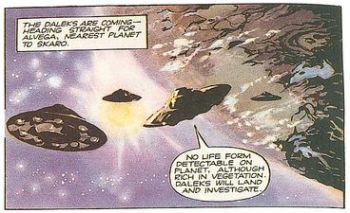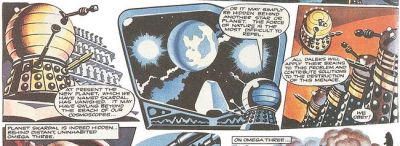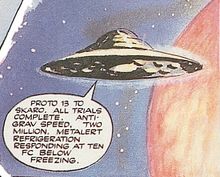1965 – the year Diana Rigg joined the cast of The Avengers, as Emma Peel.

This is… The Daleks in a 104-part epic.
Thoughts:
Serialised as one page of TV Century 21 magazine over its first 104 weekly issues over 1965 and 1966, this, “The Daleks – by Terry Nation” was actually written by Doctor Who‘s first story editor, David Whitaker (who had overseen the first appearance of the Daleks, in Doctor Who‘s second serial).
In 1965 another colourful tale of the Daleks that wasn’t Doctor Who as such was released – Dr. Who and the Daleks, the film that starred Peter Cushing as a human that had invented Tardis, rather than the TARDIS. (The Daleks were extremely popular).
This blog would argue that actually it’s this other 1965 Dalek extravaganza (of TV Century 21 magazine) that has influenced the television programme Doctor Who more. (So after 1963 An Unearthly Child and 1964 The Aztecs, this is chosen as 1965 for this history of Doctor Who.)
Television stories shown, respectively, Bad Wolf/The Parting of the Ways (2005), Remembrance of the Daleks (1988), Bad Wolf/The Parting of the Ways again, The Stolen Earth/Journey’s End (2008)…


Pictured: Dalek saucers, (of 1965), their 2005 counterparts looking very similar.


Pictured: the Dalek Emperor of TV Century 21 magazine, which preceded the 1967 and 1988 and 2005 Dalek Emperors of the television programme, (the 1988 version obviously inspired by it).
Although these panels are from 1966’s “Rogue Planet”, the globular Emperor is present in 1965 too (the panels that begin this blogpost).


Pictured: the very first appearance of this 104-part epic’s “Dalek Saucer”, on the eighteenth page. (1964’s Doctor Who The Dalek Invasion of Earth included a much less stylish Saucer – when the programme returned for the 21st Century it went with the TV Century 21 version.)

This 1965 Dalek narrative is also notable for: “Genesis of Evil” (issues 1 to 3), an alternative origin for the Daleks; “Duel of the Daleks” (issues 11 to 17) in which the Emperor is against a renegade Dalek (more inspiration for Remembrance of the Daleks again); and “The Amaryll Challenge” (issues 18-24) which is simply (and gleefully) a story of the Daleks destroying a civilisation and its planet with no humanoids involved!
“Eve of the War” (issues 47 to 51) begins December 1965 and is continued January 1966 – it has the television programme’s Mechanoids (from the 1965 Dalek story The Chase) making an appearance.
So why has this 1965-and-1966 comics version of the Daleks been so influential? One reason would be that it wasn’t forgotten (the episodes were kept, unlike some of the junked Dalek TV episodes of the Sixties), and it was re-issued, often in its dazzling colour, in the pages of DWM in the early Eighties: no doubt RTD was a keen reader and his love of comics is something he’s not reticent about.
What of the television programme itself though, in 1965? 
Though it had established what the basic elements of itself, the programme, were: the Daleks (they would have two returning story-appearances in 1965), the Doctor and his TARDIS and his companions, it was this fourth element – the companions – that was most in flux.
By the end of June 1965, Doctor Who had said goodbye to Ian and Barbrara (it had already said goodbye to Susan) and so all the original companions had gone. There would be rapid series of “Susan replacements” – Vicki, Katarina, and 1966’s Dodo – though 1966 which would be the year of the “glam companion” Polly, a model for the future.
Sara Kingdom (played by Jean Marsh) was the proto-glam-companion, both her and Emma Peel being modelled on The Avengers’ Cathy Gale.
She made her appearance in the second Dalek TV story of 1965, The Daleks’ Master Plan.
Editions: Originally published in issues 1 to 104 of TV Century 21 magazine (one page at a time), over January 1965 to January 1967.
There were sixteen story-arcs, each about 6 pages long.
There were then some significant reprints by Doctor Who Magazine (and “DWM” will be used to indicate the various incarnations, Doctor Who Weekly, Doctor Who Monthly).
DWM 33 to 42 (1980) reprinted the first seven arcs as “The Dalek Tapes”.
DWM 53 to 55 (1981) reprinted the eighth and ninth arc.
DWM 56, 58 to 60 reprinted the tenth arc “Rogue Planet” (a prelude to the next arc), with one full-colour page per issue.
DWM 61 to 66, 68 (1982) reprinted the eleventh arc, “Impasse”, with one full-colour page per issue.
The whole epic – reprinted in DWM 180 to 193 (and Doctor Who Classic Comics 1 to 19) and a 1994 special.
Continuity notes: Could this then fit into the narrative of Doctor Who, in a way that the Cushing Dr Who films could not? (There are so many basic continuity clashes the film Dr Who and TV Doctor Who could never be reconciled as one thing.)
The biggest continuity clash is that “Yarvelling” was the scientist involved with the Genesis of the Daleks rather than Davros, while the un-mutated Kaleds (or Dals or Daleks) are little blue men rather than human-looking like the Thals. However the 3-page “Genesis” story could be read as a Dalek folk-tale (with Davros lost to the mists of time) while Genesis of the Daleks remains their “proper” origin: so yes, this could fit into the narrative of Doctor Who.
(The thirteenth arc, 1966’s “Legacy of Yesteryear”, includes the blue men again which is more difficult to resolve.)
Programme ethos: n/a
Precursors: The saucers are in the Science Fiction cinema tradition.
Sound and Vision: Art – by Richard Jennings for broadly the first half of the epic (1965), and by Ron Turner for the second half (1965), with Eric Eden on the ninth arc only.
(The eight arc “Eve of the War” of December 1965 and January 1966 drawn by Jennings then Turner.)
The extracts shown are all by Richard Jennings (from the fourth arc “The Amaryll Challenge”) except for the third extract (the Dalek Emperor from the tenth arc “Rogue Planet”) by Ron Turner.
World of Fandom: Dalek Empire – Big Finish.
(Big Finish has been producing BBC-licensed Doctor Who spin-off audios since 1999 – their Dalek Empire series of 2001 onwards reviving the spirit of TV Century 21’s Daleks, with Dalek saucers streaming across the galaxies well before the revival of the television programme.)
Product:
Nothing that’s in-print, though back-issues of those issues mentioned by “Editions” can be found.
Episodes 2, 5, and 10 (with Sara Kingdom in the latter two) of The Daleks’ Master Plan are on the Doctor Who: Lost in Time DVD boxset.
———
(The Daleks’ Master Plan on bbc.co.uk/programmes/)
———
Next Wednesday – Doctor Who 1966 and more Sara Kingdom…
Leave a comment